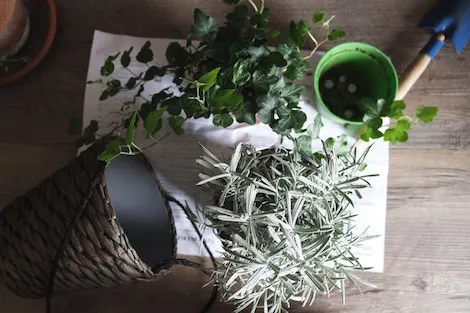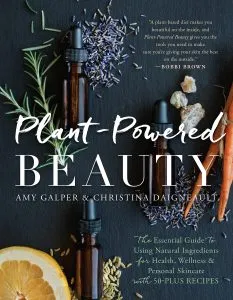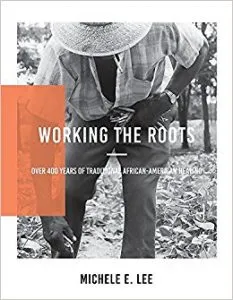
Books About Herbalism and Natural Skincare
This content contains affiliate links. When you buy through these links, we may earn an affiliate commission.
In the past few years of yoga teaching, book reading, and long hikes into the woods around southeastern England, I fell in love with plants and flowers. It came as a bit of a surprise to me and I expected my interest to dwindle over time, but the affliction has only gotten worse (to the extent that I recently acquired an allotment in London, and am poised to spend the next year of my life clearing, growing, and harvesting on it).
In the course of my learning about plants and flowers, I picked up an interest in herbalism and natural beauty and skincare. I’ve long been against animal testing, micro-beads and falsely advertised ‘miracle creams’, so the idea of being able to make my own skincare and some small healing concoctions for my cupboards was very appealing.
My allotment is set to feature an apothecary section (the guy on the plot next to mine was baffled the other day to see me putting a dandelion plant into a flower pot, but I didn’t stop to explain what I was up to so he likely thinks I’m a bit eccentric). I picked up the idea from Rosemary Gladstar’s Medicinal Herbs, a little beginner’s guide that, though based in the United States, gave me great ideas about where to start, what to grow and why to grow it. Richly illustrated, the book guides a reader through the very first steps of getting into herbs and their various applications with lots of recipes to attempt at minimum cost.
 In all my reading, it’s been fun for me to realise that female authors dominate the bookshelves of herbalism—the history of healing and hedge-witches has clearly had a long term impact and women have produced some wonderful, hyper-contemporary books on the topic—Plant Powered Beauty by Amy Galper and Christina Daigneault tackles the secrets of plant-based, all-natural skincare, removing much of the waste, dangerous byproducts and cost of proper skincare. I’ve always been a Lush addict, but being able to make my own skincare at home has been a revelation and there’s a real sense of triumph with even the smallest efforts—I also read The Handmade Apothecary by Kim Walker and Vicky Chown, which focuses on recipes for different parts of the body, including some (rather delicious) healthy sweet treats.
In all my reading, it’s been fun for me to realise that female authors dominate the bookshelves of herbalism—the history of healing and hedge-witches has clearly had a long term impact and women have produced some wonderful, hyper-contemporary books on the topic—Plant Powered Beauty by Amy Galper and Christina Daigneault tackles the secrets of plant-based, all-natural skincare, removing much of the waste, dangerous byproducts and cost of proper skincare. I’ve always been a Lush addict, but being able to make my own skincare at home has been a revelation and there’s a real sense of triumph with even the smallest efforts—I also read The Handmade Apothecary by Kim Walker and Vicky Chown, which focuses on recipes for different parts of the body, including some (rather delicious) healthy sweet treats.
 Herbal medicine has been around since the annals of ancient human history, diverging from the history of medicine with the dawn of the scientific method in the 19th century. Pharmaceuticals (often derived themselves from plants) have become the dominant medical treatment on offer, but for many communities herbal and traditional medicine are ingrained in cultural histories to the extent that removing them is a whitewash. During slavery, traditional medicine was necessity to ensuring a higher change of survival for black communities across America—it’s worth picking up Working the Roots: Over 4oo Years of African American Healing by Michele Elizabeth Lee to see both the inherent weight of that history and the practical development and application of those necessary basics over time.
Native Americans were deeply invested in herbal medicine long before the establishment of the Colonies—A Taste of Heritage by Alma Hogan Snell focuses in on the experiences of her Crow Tribe family in the 1920s and ’30s, weaving history together with recipes. It’s not too often that I say this, but the book is a proper eye opener; I knew nothing about the Crow Tribe and just reading it made me all too aware of the risk of losing so much cultural history by neglecting minority communities.
Bearing in mind all I’ve read, I’m hoping to get moving on my apothecary garden in the next few months (if the sun ever returns to the UK)—let’s hope I’ve learned enough to bring some plants to life!
Herbal medicine has been around since the annals of ancient human history, diverging from the history of medicine with the dawn of the scientific method in the 19th century. Pharmaceuticals (often derived themselves from plants) have become the dominant medical treatment on offer, but for many communities herbal and traditional medicine are ingrained in cultural histories to the extent that removing them is a whitewash. During slavery, traditional medicine was necessity to ensuring a higher change of survival for black communities across America—it’s worth picking up Working the Roots: Over 4oo Years of African American Healing by Michele Elizabeth Lee to see both the inherent weight of that history and the practical development and application of those necessary basics over time.
Native Americans were deeply invested in herbal medicine long before the establishment of the Colonies—A Taste of Heritage by Alma Hogan Snell focuses in on the experiences of her Crow Tribe family in the 1920s and ’30s, weaving history together with recipes. It’s not too often that I say this, but the book is a proper eye opener; I knew nothing about the Crow Tribe and just reading it made me all too aware of the risk of losing so much cultural history by neglecting minority communities.
Bearing in mind all I’ve read, I’m hoping to get moving on my apothecary garden in the next few months (if the sun ever returns to the UK)—let’s hope I’ve learned enough to bring some plants to life!
 In all my reading, it’s been fun for me to realise that female authors dominate the bookshelves of herbalism—the history of healing and hedge-witches has clearly had a long term impact and women have produced some wonderful, hyper-contemporary books on the topic—Plant Powered Beauty by Amy Galper and Christina Daigneault tackles the secrets of plant-based, all-natural skincare, removing much of the waste, dangerous byproducts and cost of proper skincare. I’ve always been a Lush addict, but being able to make my own skincare at home has been a revelation and there’s a real sense of triumph with even the smallest efforts—I also read The Handmade Apothecary by Kim Walker and Vicky Chown, which focuses on recipes for different parts of the body, including some (rather delicious) healthy sweet treats.
In all my reading, it’s been fun for me to realise that female authors dominate the bookshelves of herbalism—the history of healing and hedge-witches has clearly had a long term impact and women have produced some wonderful, hyper-contemporary books on the topic—Plant Powered Beauty by Amy Galper and Christina Daigneault tackles the secrets of plant-based, all-natural skincare, removing much of the waste, dangerous byproducts and cost of proper skincare. I’ve always been a Lush addict, but being able to make my own skincare at home has been a revelation and there’s a real sense of triumph with even the smallest efforts—I also read The Handmade Apothecary by Kim Walker and Vicky Chown, which focuses on recipes for different parts of the body, including some (rather delicious) healthy sweet treats.
 Herbal medicine has been around since the annals of ancient human history, diverging from the history of medicine with the dawn of the scientific method in the 19th century. Pharmaceuticals (often derived themselves from plants) have become the dominant medical treatment on offer, but for many communities herbal and traditional medicine are ingrained in cultural histories to the extent that removing them is a whitewash. During slavery, traditional medicine was necessity to ensuring a higher change of survival for black communities across America—it’s worth picking up Working the Roots: Over 4oo Years of African American Healing by Michele Elizabeth Lee to see both the inherent weight of that history and the practical development and application of those necessary basics over time.
Native Americans were deeply invested in herbal medicine long before the establishment of the Colonies—A Taste of Heritage by Alma Hogan Snell focuses in on the experiences of her Crow Tribe family in the 1920s and ’30s, weaving history together with recipes. It’s not too often that I say this, but the book is a proper eye opener; I knew nothing about the Crow Tribe and just reading it made me all too aware of the risk of losing so much cultural history by neglecting minority communities.
Bearing in mind all I’ve read, I’m hoping to get moving on my apothecary garden in the next few months (if the sun ever returns to the UK)—let’s hope I’ve learned enough to bring some plants to life!
Herbal medicine has been around since the annals of ancient human history, diverging from the history of medicine with the dawn of the scientific method in the 19th century. Pharmaceuticals (often derived themselves from plants) have become the dominant medical treatment on offer, but for many communities herbal and traditional medicine are ingrained in cultural histories to the extent that removing them is a whitewash. During slavery, traditional medicine was necessity to ensuring a higher change of survival for black communities across America—it’s worth picking up Working the Roots: Over 4oo Years of African American Healing by Michele Elizabeth Lee to see both the inherent weight of that history and the practical development and application of those necessary basics over time.
Native Americans were deeply invested in herbal medicine long before the establishment of the Colonies—A Taste of Heritage by Alma Hogan Snell focuses in on the experiences of her Crow Tribe family in the 1920s and ’30s, weaving history together with recipes. It’s not too often that I say this, but the book is a proper eye opener; I knew nothing about the Crow Tribe and just reading it made me all too aware of the risk of losing so much cultural history by neglecting minority communities.
Bearing in mind all I’ve read, I’m hoping to get moving on my apothecary garden in the next few months (if the sun ever returns to the UK)—let’s hope I’ve learned enough to bring some plants to life!












